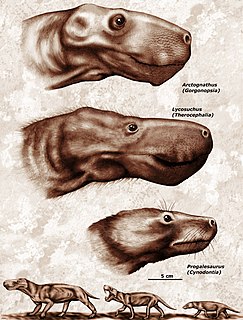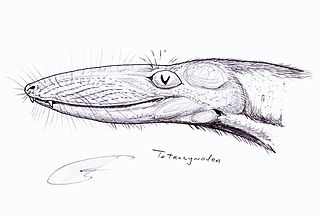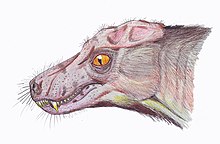
Therapsida is a major group of eupelycosaurian synapsids that includes mammals and their ancestors. Many of the traits today seen as unique to mammals had their origin within early therapsids, including limbs that were oriented more underneath the body, as opposed to the sprawling posture of many reptiles and salamanders. The earliest fossil attributed to Therapsida used to be Tetraceratops insignis from the Lower Permian. However in 2020, a new study has found that Tetraceratops is not actually a true Therapsid, but should be considered to be a member of the more ancient Sphenacodontia from which the therapsids evolved.

Therocephalia is an extinct suborder of eutheriodont therapsids from the Permian and Triassic. The therocephalians ("beast-heads") are named after their large skulls, which, along with the structure of their teeth, suggest that they were carnivores. Like other non-mammalian synapsids, therocephalians were once described as "mammal-like reptiles". Therocephalia is the group most closely related to the cynodonts, which gave rise to the mammals. This relationship takes evidence in a variety of skeletal features. The phylogeny of therocephalians has been disputed, as the monophyly of the group and the relationships of its members are unclear.

The theriodonts or Theriodontia are a major group of therapsids. They can be defined in traditional, Linnaean terms, in which case they are a suborder of synapsids that lived from the Middle Permian to the Middle Cretaceous, or in cladistic terms, in which case they include not only the traditional theriodonts but also their descendants the mammals as well.

Procynosuchidae is an extinct family of therapsids which, along with Dviniidae, were the earliest cynodonts. They appeared around 260 million years ago, and were most abundant during the latest Permian time, shortly before the Permian-Triassic extinction event. Despite being the basal member of the cynodont clade, they already showed some of the advanced mammalian characteristics, but Procynosuchids bore resemblance to the Therocephalians.

Eutherocephalia is an infraorder of therocephalian therapsids. Eutherocephalians are distinguished from the lycosuchids and scylacosaurids, two early therocephalian families. While lycosuchids and scyalosaurids became extinct by the end of the Permian period, eutherocephalians survived the Permian–Triassic extinction event. The group eventually became extinct in the Middle Triassic.

Tetracynodon is an extinct genus of therocephalian. Fossils of Tetracynodon have been found in the Karoo Basin of South Africa. Two species are known: the type species T. tenuis from the Late Permian and the species T. darti from the Early Triassic. Both species were small-bodied and probably fed on insects and small vertebrates. Although Tetracynodon is more closely related to mammals than it is to reptiles, its braincase is very primitive and shares more in common with modern amphibians and reptiles than it does with mammals.

Scymnosaurus is now considered a nomen dubium.

Akidnognathidae is an extinct family of therocephalian therapsids from the Late Permian and Early Triassic of South Africa and Russia. The family includes many large-bodied therocephalians that were probably carnivorous, including Moschorhinus and Olivierosuchus. One akidnognathid, Euchambersia, may even have been venomous. Akidnognathids have robust skulls with a pair of large caniniform teeth in their upper jaws. The family is morphologically intermediate between the more basal therocephalian group Scylacosauridae and the more derived group Baurioidea.

Scylacosauridae is an extinct family of therocephalian therapsids. Scylacosaurids lived during the Permian period and were among the most basal therocephalians. The family was named by South African paleontologist Robert Broom in 1903. Scylacosaurids have long snouts and unusual saber-like canine teeth.

Bauriidae is an extinct family of therocephalian therapsids. Bauriids were the latest-surviving group of therocephalians after the Permian–Triassic extinction event, going extinct in the Middle Triassic. They are among the most advanced eutherocephalians and possess several mammal-like features such as a secondary palate and wide postcanine teeth at the back of the jaws. Unlike other therocephalians, bauriids were herbivorous. They were also smaller than earlier members of the group. Two subfamilies are classified within Bauriidae: Nothogomphodontinae and Bauriinae.
Blattoidealestes is an extinct genus of therocephalian therapsid from the Middle Permian of South Africa. The type species Blattoidealestes gracilis was named by South African paleontologist Lieuwe Dirk Boonstra from the Tapinocephalus Assemblage Zone in 1954. Dating back to the Middle Permian, Blattoidealestes is one of the oldest therocephalians. It is similar in appearance to the small therocephalian Perplexisaurus from Russia, and may be closely related.
Ictidodon is an extinct genus of therocephalian therapsids from the Late Permian of South Africa. The type species Ictidodon agilis was named by South African paleontologist Robert Broom in 1925. Broom classified Ictidodon in the Scaloposauridae, a group of small-bodied therocephalians that are now thought to be juvenile forms of larger therocephalians. Ictidodon and many other scaloposaurids are now classified as basal members of the clade Baurioidea.
Silpholestes is an extinct genus of therocephalian therapsids from the Late Permian of South Africa. The type species Silpholestes jackae was named by South African paleontologist Robert Broom in 1948 from the Cistecephalus Assemblage Zone.
Ictidodraco is an extinct genus of therocephalian therapsids from the Late Permian of South Africa. The type species Ictidodraco longiceps was named by South African paleontologists Robert Broom and John T. Robinson in 1948 from the Cistecephalus Assemblage Zone. Ictidodraco was once classified as a scaloposaurian in the family Silpholestidae. Scaloposauria and Silpholestidae are no longer regarded as valid groups, and Ictidodraco is now classified as a basal member of the clade Baurioidea.

Macroscelesaurus is an extinct genus of therocephalian therapsid from the Late Permian of South Africa. The type species Macroscelesaurus janseni was named by Sidney H. Haughton in 1918 from the Cistecephalus Assemblage Zone. It is one of the few therocephalians known from postcranial remains.

The Eutheriodontia are a clade of therapsids that includes therocephalians and cynodonts.
Trochosuchidae is an extinct family of therocephalian therapsids from the Permian period. It includes the genera Trochosaurus, Trochosuchus, Trochorhinus, and Hyaenasuchus. Trochosuchids are known only from the Tapinocephalus Assemblage Zone of the Beaufort Group in South Africa. Trochosuchids are basal therocephalians and are similar in appearance to another primitive group of therocephalians, the Scylacosauridae. Compared to scylacosuchids, trochosuchids have broader snouts and more flattened skulls lacking prominent sagittal crests. They have two enlarged canines on either side of the upper jaw, similar to lycosuchid therocephalians but unlike scylacosuchids, which only have one pair of canines.
Lycideops is an extinct genus of therocephalians from the Late Permian of South Africa. The type species is Lycideops longiceps, named in 1931 by South African paleontologist Robert Broom. Fossils of Lycideops come from the Dicynodon Assemblage Zone of the Beaufort Group. Lycideops is a member of the family Lycideopidae. Like other lycideopids, Lycideops has a long snout.
Ichibengops is an extinct genus of therocephalian therapsids known from the type species Ichibengops munyamadziensis, which lived in what is now Zambia during the Late Permian. Ichibengops was named in 2015 on the basis of fossils found in the Wuchiapingian-age Madumabisa Mudstone Formation in the Luangwa Basin. Therocephalians have been known from the Luangwa Basin for decades, yet Ichibengops was the first endemic Zambian therocephalian to have been described in detail. Phylogenetic analysis indicates that it is a basal member of the clade Eutherocephalia, lying just outside a clade containing hofmeyriids, whaitsiids, and baurioids. Ichibengops is the sister taxon of the Russian therocephalian Chthonosaurus; together they form one of several known African-Russian sister taxon pairs of eutherocephalians, which indicate that eutherocephalians could freely disperse across most of Pangea during the Late Permian. Like the fellow therocephalian Euchambersia, Ichibengops might have been venomous, as evidenced by grooves above its teeth.
Ictidosaurus was a therapsid genus found in the Abrahamskraal Formation of South Africa, which lived during the middle Permian period. Fossils of the type species were found in the Tapinocephalus, and the base of the Eodicynodon assembly zones, of the Karoo Basin. Older classifications of the species, along with many other specimens found in the Iziko South African Museum archives, were originally classified within therocephalian family names, in this case the Ictidosauridae, which has been reclassified as belonging to the Scylacosauridae. The type species is I. angusticeps.














